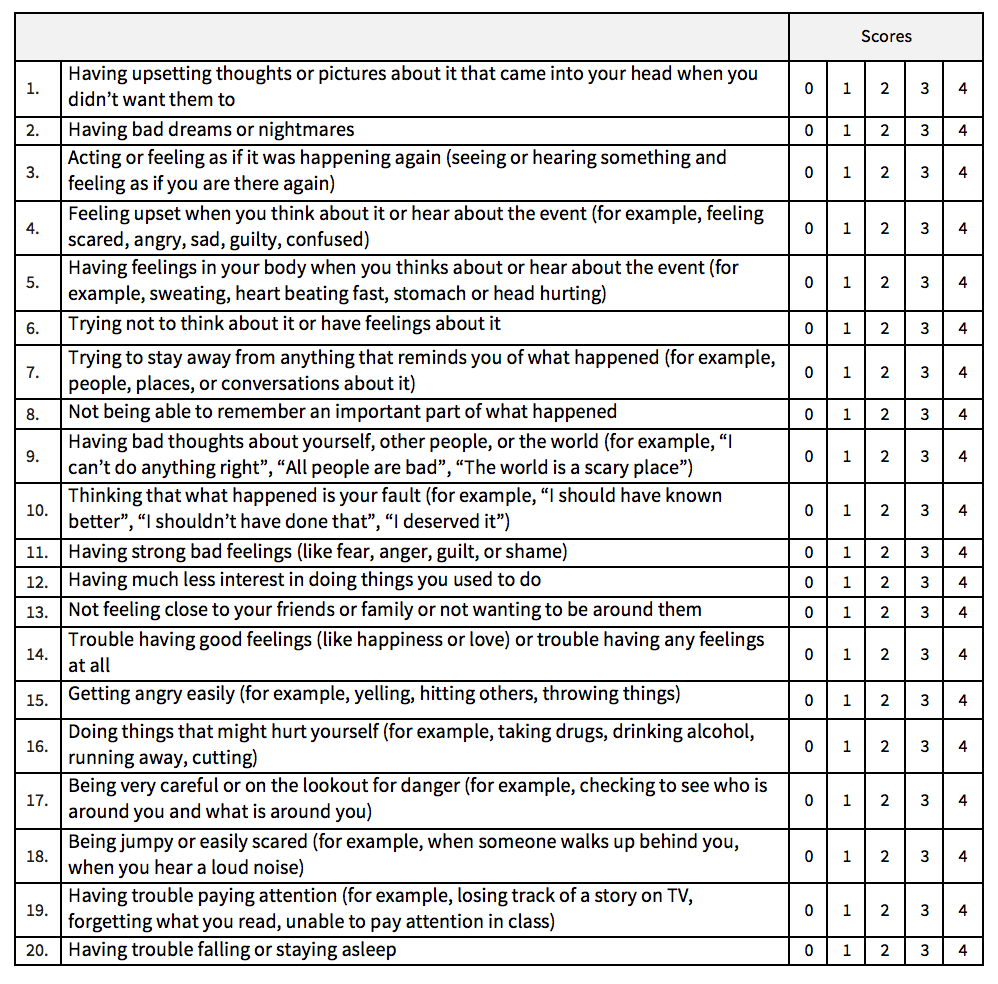
Child PTSD Symptom Scale (CPSS-5)
Recommended frequency: Every 4 weeks
Summary
The Child PTSD Symptom Scale (CPSS-5) is a 27-item measure that evaluates posttraumatic symptom severity in children and adolescents based on DSM-5 diagnostic criteria for Posttraumatic Stress Disorder.
There are two parts to the scale. The first part of the scale consists of 20 items that evaluate the frequency and severity of re-experiencing, avoidance, and hyperarousal symptoms individuals exposed to a traumatic or distressing event may have experienced over the past month on a 5-point Likert scale. The second part of the CPSS-5 contains 7 items and determines whether any of the posttraumatic symptoms have functionally impaired a certain domain of the individual’s life (e.g. “Relationships with your friends”) over the past month.
The self-report version of the scale can be used by individuals between the ages of 8 to 18. There is a therapist-complete version that can be administered in-session with a child. A parent/caregiver version has also been developed; although, this measures has not been empirically validated. The CPSS-5 can be used to measure changes in PTSD symptoms and assess for childhood and adolescent PTSD diagnoses.
Psychometric Properties of the CPSS-5
The CPSS-5 demonstrates excellent internal consistency (αs = .92) and good test-retest reliability (r = .80) for its total score. It also demonstrates good convergent validity and discriminant validity with the Multidimensional Anxiety Scale for Children (MASC) and Child Depression Inventory (CDI).
Assessments on Greenspace
Interested in learning more about how Greenspace can simplify and enhance your measurement practice?
Book a CallThe Scale
Sometimes scary or upsetting things happen to kids. It might be something like a car accident, getting beaten up, living through an earthquake, being robbed, being touched in a way you didn’t like, having a parent get hurt or killed, or some other very upsetting event. These questions ask how you feel about an upsetting thing that you experienced.
Read each question carefully. Then select the number (0-4) that best describes how often that problem has bothered you IN THE LAST MONTH.

Have the problems above been getting in the way of the following parts of your life IN THE PAST MONTH?

Scoring the CPSS-5
The first part of the CPSS-5 assesses symptom severity, which is calculated by assigning 0-4 to the response categories of:
0 – Not at all / only at one time
1 – Once a week or less / a little
2 – 2 to 3 times a week / somewhat
3 – 4 to 5 times a week / a lot
4 – 6 or more times a week / almost always
Scores for the first part of the scale range from 0-80, higher scores indicating greater symptom severity. A cutoff score of 31 or higher in part one of the CPSS-5 is recommended for identifying probable PTSD.
The second part of the scale assesses functional impairment. Individuals rate whether any of the endorsed symptoms have affected their functioning. Points are assigned from 0-1 to the response categories “No” and “Yes”, respectively. Scores for the second part of the scale range from 0-7, higher scores revealing greater functional impairment.

Copyright Information
Foa, E.B., Johnson, K.M., Feeny, N.C., & Treadwell, K.R.H. (2001). The child PTSD symptom scale (CPSS): A preliminary examination of its psychometric properties. Journal of Clinical Child Psychology, 30, 376-384.












